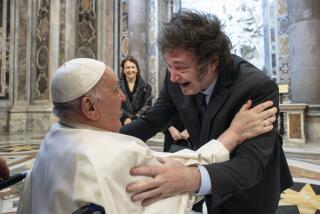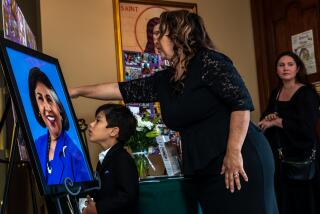She Nourished Not Just Bodies, but Souls
- Share via
CALCUTTA — Everyone around the world mourns the loss of Mother Teresa, but it is not until you actually visit this country of 936 million people that you begin to understand what drove this woman from Albania to go to India to serve the poorest of the poor.
I am here for the funeral of the “Angel of Mercy” and “Saint of the Gutters.” Visiting this beautiful and complex country, I see that its greatest asset is not in its natural resources, but in its people. It is here that one easily recognizes the undying light of humanity, despite suffering and hardship. Although only a very small percentage of the population is Christian, Mother Teresa was accepted into this Hindu-dominated country and has become its beloved adopted daughter. Grateful of her work here, people turned out in huge numbers to pay their final respects to an amazing human being.
Mother Teresa said she saw Jesus in the faces of the sick and the unwanted whom she served, and looking around at the teeming life in this city, I see him too. Now, as I watch the sisters of the Missionaries of Charity, which she founded, doing God’s work in their traditional blue and white garb, I am reminded of Mother Teresa’s words to me when I interviewed her recently in Tijuana. She was in Mexico because she wanted to give God’s love, compassion and presence to the hungry and the poor there.
“Faith in action is love,” Mother Teresa told me. “And love in action is service. And the fruit of service is peace.” She clearly believed in the power of love to bring peace to a troubled world. I reminded her that she once told me how we try to save people from starvation, but that people in America are dying of emotional starvation. It is much harder, she told me, to save someone from emotional starvation. It is easy to help a hungry man--just give him some food. But the real task is nourishing the soul.
Mother Teresa did not “want people to give me from their abundance.” She instead asked that we share our love for one another. That way, she believed, it would be easier for those who feel they cannot afford the time and the effort to help those in our world who need love the most. She was saddened by our preoccupation with “the things of the Earth,” which leaves us with no time for God.
“Why don’t many human beings believe in God?” I asked. Her answer: “Distractions. There are so many distractions.” I think what she was trying to convey is that we attempt to sate our emotional hunger with material things, which only leaves us more hungry. We need to be reminded that it is often those who have nothing who feel the richest.
Mother Teresa was always on the lookout for those who had a capacity for joy to assist her in her missionary work. She told me that the more her sisters smile and express joy, the better their work. Most people, including me, find it hard to smile and remain cheerful when we see so much suffering and death in the world. But Mother Teresa teaches us that love, expressed in a smile and in our work, is “the best medicine.”
Her theology centered on the dignity of the individual, and she sought throughout her life to bring dignity to both the living and the dying. She once was asked why she does not teach those she cared for how to fish instead of giving them a fish when they are hungry. Her reply was that her role is to give charity because that is what was needed at the moment they are too weak to hold a fishing pole. She told others to teach the street children how to fish and to help them to their feet again so that they had the strength to catch fish on their own.
This is Mother Teresa’s legacy. She has taught us that God has given us a responsibility to our brothers and sisters, to look after them and care for them. We all have a duty to help the neediest, the lowest and the poorest, after the example that Christ set for us. Mother Teresa truly is the first lady of the 20th century.
As I closed my interview with her, I asked that she please pray for me to be what Jesus wants me to be. She wrote the blessing in her own hand, pen gripped firmly between her broken fingernails. It hangs on my wall today. “Let Jesus use you without consulting you first.”


